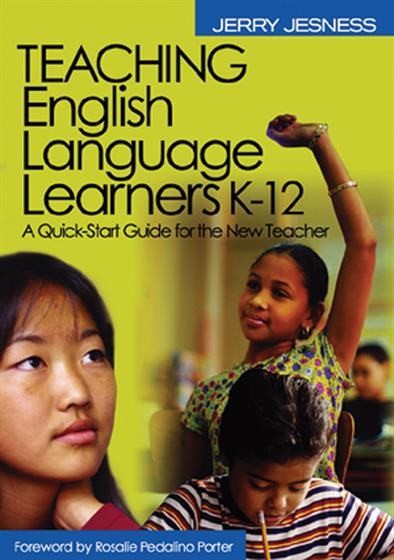Preface
Acknowledgments
About the Author
1. The Joys and Challenges of Teaching English as a Second Language
The Joys of Teaching ESL
The Challenges of Teaching ESL
Travel the World With or Without Leaving Your Classroom
It's More Than a Job, It's a Mission
2. Your Students
ESL, ELL, LEP, and Other Acronyms
Placement in Bilingual and ESL Programs
SEP Students (Someone Else's Problem)
Inclusion and Support in Regular Classrooms
3. Your Toolbox
The Textbook
Other Books
Realia: Pictures, Maps, Charts, Toys, and More
Audio Tapes and CDs
Gadgets Galore
Paying for Your Tools
Getting Help from Volunteers
Getting Advice and Help from School Personnel
4. How Much? How Soon? How Fast?
BICS and CALP
Pie-in-the-Sky Goals
Is One Year Enough?
When Should Students Exit to Regular Classes?
Steep Hills and Frustrating Plateaus
Motivation Inside and Outside of Class
Sidebar: Working with Younger Students
5. Using the Learners' Native Language in the Classroom
Don't Force Them to Go Mute
What Works Best in the Students' Native Language
Consider the Language and Culture of the Community
Use Time Limits
Sidebar: Working with Younger Students
6. Natural and Unnatural Approaches to Learning English
The Natural Approach: Learning English by Hearing It and Speaking It
Applying First Language Skills to Second Language Learning
Balancing Experiential and Analytic Approaches
Using Total Physical Response (TPR)
Language in the Foreground and the Background
Winning Over the Skeptics in Your School
Sidebar: Working with Younger Students
7. Building Vocabulary: They'll Need Lots
Enjoying the Path to a Large Vocabulary
Learning from the Movies
Teaching Vocabulary with Picture Dictionaries
Using Vocabulary from the Native Language
Using Vocabulary From the Native Language
Using Vocabulary from the Native Language
Building Vocabulary with Word Blocks
Idioms and Other Confusing Expressions
Look It Up!: Learning English with Dictionaries
Electronic Dictionaries
Those Boring Vocabulary Lists
Layered Vocabulary Learning
Sidebar: Working with Younger Students
Sidebar: Working with Younger Students
8. Grammar: The Skeletal System of the Language
Me Very Grammar
When to Start Grammar Lessons
English Grammar Isn't as Tough as We Think
Freebies: When English Grammar Matches the Learner's Native Language
The Garden Path to English Grammar
Pronoun Cases
Implicit and Explicit Grammar Instruction
Pattern Practice Makes Perfect: Well, not Really, But It Works
Grammar in Action: Questions, Answers, Jokes, and Conversation
Tag, You're It: Converting Statements to Tag Questions
Sidebar: Working with Younger Students
9. Listening Skills: The Gateway to Language
Learning with a Tape Recorder or CD Player
Learning with Software: The Rosetta Stone, Instant Immersion, and Other Programs
The Great ESL Film Festival
Dictations
Encouraging Listening as a Stand-Alone Skill
Teaching with Minimal Pairs: Bit, Bet, Bait, Beet, Bite
Sidebar: Working with Younger Students
Chapter 10. Now Say It: Teaching Spoken English
The Direct Method
Controlled Conversation
Role Playing
Student-to-Student Teaching
Recitals
Using Media and the Language Lab
Teaching Pronunciation (Speech Therapists Can Help!)
Using the International Phonetic Alphabet
Error Correction: When and How Often
Let Your Students Correct You Too
Speaking Practice Outside of Class
Sidebar: Working with Younger Students
11. Teaching Reading
When Students Are Struggling Readers in Their Native Language
Quick-Start Phonics for English Learners
The Constant Consonants
Those Tricky Vowels
Decoding Skills and Background Knowledge
Graphic Organizers
Sidebar: Working with Younger Students
12. Writing It Right
Getting Started
Writing Begins with Spelling
Gadgets and Media Again
The Vanishing Word Technique
Picture and Word Cards
Punctuation and Capitalization
Dictation
In Their Own Words
Sidebar: Working with Younger Students
13. How We Know What the Students Know: Grading and Testing
Grading in Mixed Ability Classrooms
Individualized Education Plans
Multi-Track Grading: Same Class, Different Goals
No, You Aren't Cheating: What Counts for General Learners and College Prep Learners
Keeping Noses to the Grindstone
Testing Vocabulary
Testing Spelling
Testing Speaking and Listening
Testing Grammar
Self-Assessment: Giving Students Their Own Checklists
Preparing Students for Standardized Tests (Please Don't)
Sidebar: Working with Younger Students
14. Teaching English Learners with Special Needs
Prior Education, Semilingualism, and Learning Disabilities
What Does Special Education Offer Your Students?
When They Need a Special Education Referral But Haven't Gotten One
Determining the Appropriate Program
Sidebar: Working with Younger Students
15. English Learners in Content Classes
English Throughout the Curriculum
Sheltered English Content Classes
Content Objectives and Language Objectives
A Sample Sheltered Science Lesson
A Sample Sheltered Vocabulary Lesson
Using Sheltered English to Teach and Practice Grammar
When Are Students Ready to Wade into the Mainstream?
The Power of Prior Knowledge
The Power of Incidental Learning
Reasonable and Unreasonable Modifications in the Inclusive Classroom
The F Word (Failure)
The Bright Side: Enriched Class Discussions
Out-of-Class Support for English Learners in Regular Content Classes
16. Helping Everyone Else Understand Your Students
Attitudes Make the Difference: Racism and Xenophobia
I'm Here, So Shut the Door Already
Exposing Other Students to Your Students' Culture
Avoiding Trivial Pursuit and Superficial Multiculturalism
Illuminating with Literary Classics From Other Traditions
Living Social Studies
Graphic Art and Music
Mutual Tutoring and Dual Immersion
17. Preparing Yourself to Be a Better ESL Teacher
Catching Up and Keeping Up with Advances in the Field
Acquainting Yourself with Your Students' Culture
Trying on Your Students' Shoes
And If You Teach at the Base of the Tower of Babel...
Vocabulary Lists
Numbers 1 - 10
Shapes
Numbers 11-20
People and Things
Numbers by Tens
Colors
All Numbers to 100
U.S. Currency
Time
Classroom Nouns
Classroom Verbs
Large Numbers: Hundred and Thousands
Arithmetic I: Addition and Subtraction
Alphabet A - H
Arithmetic II: Multiplication and Division
Alphabet I - P
School Supplies
Alphabet Q - Z
Computer Nouns
Computer Verbs
Human Body
Family
Home Nouns
Home Verbs
Park and Playground
Pets and Pet Accessories
Farm Animals
Wild Animals
World Geography: Continents and Countries
U.S. Geography: Oceans, Rivers, Mountain Ranges, Borders
Ordinal Numbers
City Geography: Streets, Avenues, Buildings, Directions, Travel
Fruit and Vegetables
Meat and Seafood
Bakery Products
Dairy Products
Women's Clothing
Men's Clothing
Emotions
Baseball
Possessive Pronouns
Prepositions and Their Objects
Glossary
Recommended Reading
Recommended Websites
References
Index



